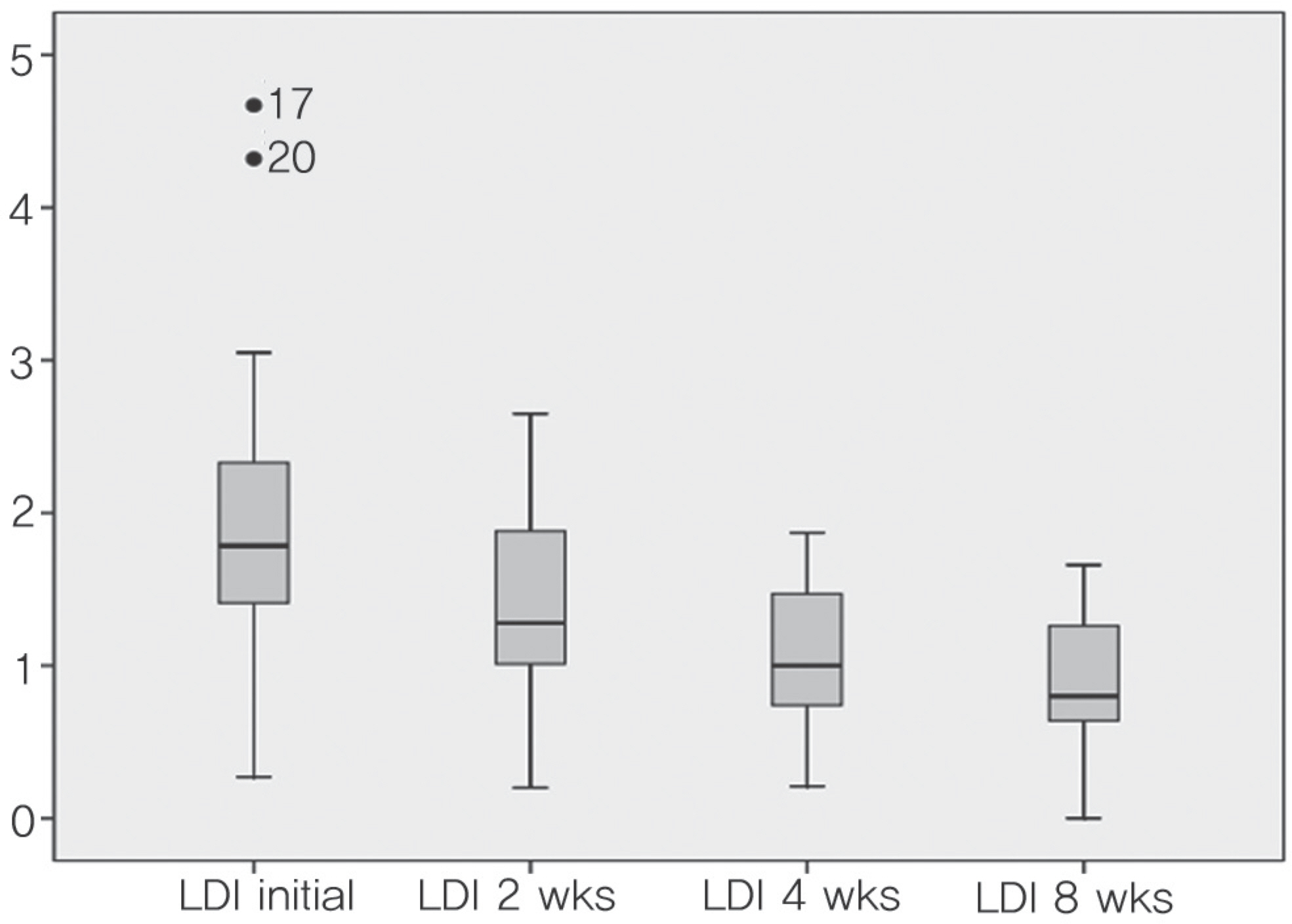J Korean Soc Spine Surg.
2011 Dec;18(4):202-207. 10.4184/jkss.2011.18.4.202.
The Treatment of Traumatic Atlantoaxial Rotatory Subluxation (Fielding Type I) and the Correlation between the Clinical Progress and Radiological Reduction Parameter
- Affiliations
-
- 1Department of Orthopedic Surgery, National Police Hospital, Seoul, Korea. osahnyj@lycos.co.kr
- KMID: 1447997
- DOI: http://doi.org/10.4184/jkss.2011.18.4.202
Abstract
- STUDY DESIGN: This is a retrospective study.
OBJECTIVES
We will discuss clinical outcomes of adult traumatic atlantoaxial rotatory subluxation (Fielding type I) and verify the correlation between the clinical outcomes and radiological reduction rate. SUMMARY OF LITERATURE REVIEW: Atlantoaxial rotatory subluxation which usually occur in children by non-traumatic sources or minor trauma has been discussed persistently. However, studies of atlantoaxial rotatory subluxation which occur in adults over 20 years old, especially by traumatic injury is rare.
MATERIALS AND METHODS
From October 2004 to April 2011, thirty patients diagnosed of traumatic atlantoaxial rotatory subluxation with 6 months follow-up period were enrolled in the study. After diagnosis, we started treating Halter traction with 5 lbs. We discontinued traction when the patient recovered over 90% of ROM and applied Philadelphia collar to the patient. We measured visual analogue scale (VAS) for cervical pain and ROM. We measured atlanto-dens interval (ADI) and lateral mass-dens interval (LDI) difference using three-dimensional computed tomography (3D-CT) to validate radiological reduction rate.
RESULTS
At the end of follow-up, none of the patients complained over pain and all recovered to full ROM. ADI was in normal range during the whole treatment period. LDI difference gradually decreased during treatment period, however, only 8 cases (26.7%) came back to normal range.
CONCLUSIONS
In traumatic atlantoaxial rotatory subluxation (Fielding type I), satisfactory clinical outcomes such as pain relief or ROM improvement using traction and the radiological reduction rate was also improved but it failed to achieve a complete reduction of LDI difference in radiography.
MeSH Terms
Figure
Reference
-
1. Mihara H, Onari K, Hachiya M, Toguchi A, Yamada K. Followup study of conservative treatment for atlantoaxial rotatory displacement. J Spinal Disord. 2001; 14:494–9.
Article2. Fielding JW, Hawkins RJ. Atlantoaxial rotatory fixation. (Fixed rotatory subluxation of the atlantoaxial joint). J Bone Joint Surg Am. 1977; 59:37–44.
Article3. Maheshwaran S, Sgouros S, Jeyapalan K, Chapman S, Chandy J, Flint G. Imaging of childhood torticollis due to atlantoaxial rotatory fixation. Childs Nerv Syst. 1995; 11:667–71.
Article4. Subach BR, McLaughlin MR, Albright AL, Pollack IF. Current management of pediatric atlantoaxial rotatory subluxation. Spine (Phila Pa 1976). 1998; 23:2174–9.
Article5. Castel E, Benazet JP, Samaha C, Charlot N, Morin O, Saillant G. Delayed closed reduction of rotatory atlantoaxial dislocation in an adult. Eur Spine J. 2001; 10:449–53.
Article6. Rinaldi I, Mullins WJ, Delaney WF, Fitzer PM, Tornberg DN. Computerized tomographic demonstration of rotational atlantoaxial fixation. J Neurosurg. 1979; 50:115–9.
Article7. Hicazi A, Acaroglu E, Alanay A, Yazici M, Surat A. Atlantoaxial rotatory fixation-subluxation revisited: a computed tomographic analysis of acute torticollis in pediatric patients. Spine (Phila Pa 1976). 2002; 27:2771–5.8. Ishii K, Chiba K, Maruiwa H, Nakamura M, Matsumoto M, Toyama Y. Pathognomonic radiological signs for predicting prognosis in patients with chronic atlantoaxial rotatory fixation. J Neurosurg Spine. 2006; 5:385–91.
Article9. Muniz AE, Belfer RA. Atlantoaxial rotary subluxation in children. Pediatric Emerg Care. 1999; 15:25–9.10. Pang D, Li V. Atlantoaxial rotatory fixation; part 3-a prospective study of the clinical manifestation, diagnosis, management, and outcome of children with alantoaxial rotatory fixation. Neurosurgery. 2005; 57:954–72.
Article11. Crockard HA, Rogers MA. Open reduction of traumatic atlantoaxial rotatory dislocation with use of the extreme lateral approach. A report of two cases. J Bone Joint Surg Am. 1996; 78:431–6.
Article12. Boos N, Khazim R, Kerslake RW, Webb JK, Mehdian H. Atlantoaxial dislocation without fracture: case report of an ejection injury. J Bone Joint Surg Br. 1997; 79:204–5.13. Jones RN. Rotatory dislocation of both atlantoaxial joints. J Bone Joint Surg Br. 1984; 66:6–7.
Article14. Moore KR, Frank EH. Traumatic atlantoaxial rotatory subluxation and dislocation. Spine (Phila Pa 1976). 1995; 20:1928–30.
Article15. Born CT, Mure AJ, Iannacone WM, DeLong WG. Three-dimensional computerized tomographic demonstration of bilateral atlantoaxial rotatory dislocation in an adult: report of a case and review of the literature. J Orthop Trauma. 1994; 8:67–72.
Article16. Robertson PA, Swan HA. Traumatic bilateral rotatory facet dislocation of the atlas on the axis. Spine (Phila Pa 1976). 1992; 17:1252–4.
Article17. De Beer JD, Thomas M, Walters J, Anderson P. Traumatic atlantoaxial subluxation. J Bone Joint Surg Br. 1988; 70:652–5.
Article18. Miyamoto H, Doita M, Nishida K, et al. Traumatic anterior atlantoaxial subluxation occurring in a professional rugby athlete: case report and review of literature related to atlantoaxial injuries in sports activities. Spine (Phila Pa 1976). 2004; 29:E61–4.19. Maiman DJ, Cusick JF. Traumatic atlantoaxial dislocation. Surg Neurol. 1982; 18:388–92.
Article20. Wise JJ, Cheney R, Fischgrund J. Traumatic bilateral rotatory dislocation of the atlantoaxial joints: a case report and review of the literature. J Spinal Disord. 1997; 10:451–3.21. Kim JH, Kim SS, Choi YS. Delayed rupture of the transverse atlantal ligament complicated after the treatment of posterior neck abscess. J Korean Soc Spine Surg. 2006; 13:120–5.22. Chang H, Park JB, Kim SK, Choi WS, Chun SK. Traumatic atlanto-occipital rotatory posterior dislocation combined with atlantoaxial rotatory subluxation: A case report. J Korean Soc Spine Surg. 1998; 5:326–32.23. Fielding JW, Hawkins RJ, Ratzan SA. Spine fusion for atlantoaxial instability. J Bone Joint Surg Am. 1976; 58:400–7.
Article24. Roche CJ, O'Malley M, Dorgan JC, Carty HM. A pictorial review of atlantoaxial rotatory fixation: key points for the radiologist. Clin Radiol. 2001; 56:947–58.
Article
- Full Text Links
- Actions
-
Cited
- CITED
-
- Close
- Share
- Similar articles
-
- A Morphologically Atypical Case of Atlantoaxial Rotatory Subluxation
- Role of the O-arm and Computer-assisted Navigation of Safe Screw Fixation in Children with Traumatic Rotatory Atlantoaxial Subluxation
- Combined Atlantoaxial Rotatory Fixation and Unilateral Counter Occipitoatlantal Subluxation after Minor Trauma
- Torticollis and Atlantoaxial Rotatory Subluxation after Chiropractic Therapy
- Post-traumatic Atlantoaxial Rotatory Dislocation in an Adult Treated by Open Reduction and C1-C2 Transpedicular Screw Fixation



